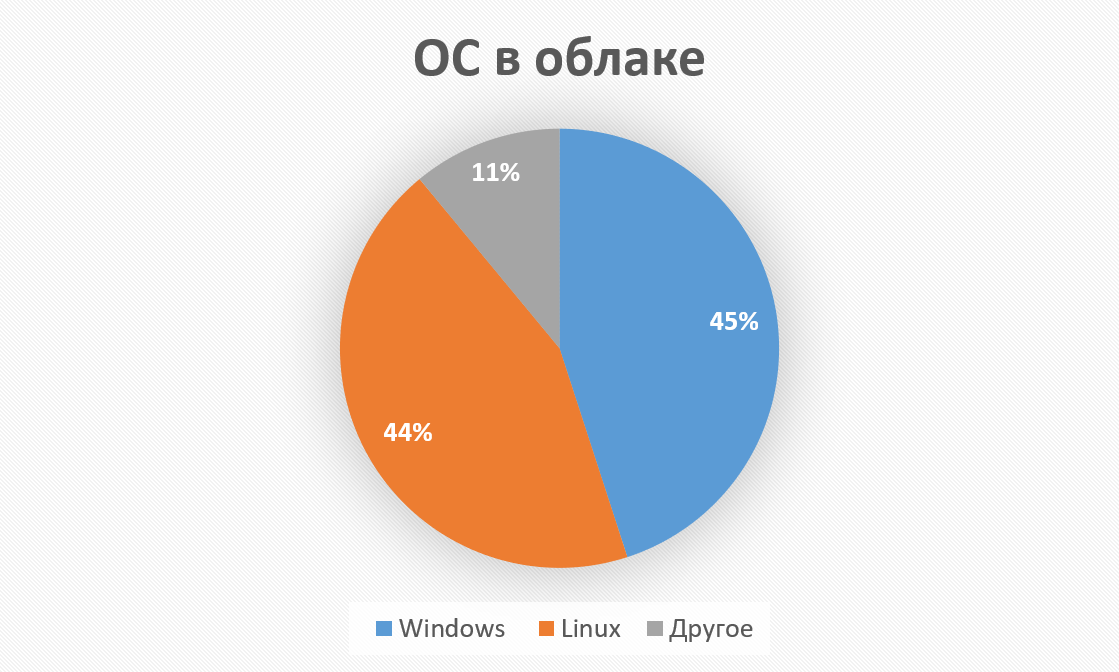Research: Linux is still the most popular OS in the cloud
We discuss the statistics of foreign IaaS providers, provide figures for our cloud and talk about the reasons that influenced such an open source OS distribution. Photos - Ian Parker - Unsplash

According to IDC, in 2017, 68% of in-house and cloud-based corporate servers were running Linux. Since then, this figure has increased - this trend is traced by many IaaS providers.
In 2015, Microsoft officials said that every fourth instance in the Azure cloud runs under Linux. Two years later, their number was 40%. This year, the number of Linux machines has exceeded 50% . The IT company itself has also become an active user of an open operating system. For example, software-defined networks (SDN) of an organization are built on its basis.
A similar picture is observed in the clouds of other IaaS providers. For example, in the 1cloud.ru cloud, Linux runs 44% of virtual machines. In the case of Windows, this figure is 45%.

Shares of operating systems on active servers in the cloud 1cloud
The forecast is confirmed by the statistics of other IaaS providers. For example, in the private cloud of one of the largest western suppliers on Linux, more than 90% of instances work .
At the same time, the open source operating system remains the most popular platform for web hosting. According to the W3Techs analytical agency, 70% of the ten million most popular sites are deployed on Linux servers (according to the Alexa ranking ). The remaining 30% is owned by Windows.
Experts identify at least two factors that affect the distribution of the operating system in the cloud.
Architecture flexibility. This factor is considered one of the determining factors in the Linux Foundation . Linux is suitable for performing diverse tasks and works on platforms of various sizes: from mobile devices to supercomputers. For example, in 2017, 498 top-500 supercomputers were running this open-source operating system. But by the end of that year, Linux began to work 100% of computers in the top.
The Most Powerful Supercomputer To Date - IBM's Summit - Run by Linux. The first exaflops supercomputer in the United States, which they plan to finish in 2021, will also work on the basis of this open source OS .
Vast community. The Linux code base is updated approximately every ten weeks . Since 2005, more than 15 thousand engineers have contributed to the development of the core. Among them are employees of 200 large corporations. Only in 2017, 3% of the changes in the code base were made by developers from Google and Samsung. Over 13% of the changes are “responsible” in Intel.

Photo - Ian Parker - Unsplash
Large IT companies are actively involved in the development of both Linux itself and open-source products based on it. Microsoft offers a platformAzure Sphere for IoT applications, which is based on the Linux kernel. Intel launched the cloud project Clear Linux , in which engineers optimize the open source OS to run on their processors. HPE offers ClearOS to ship with its hardware. IBM acquired RedHat and is now developing one of the most popular distributions on the market.
New open source products are actively deployed in the cloud, which has a positive effect on the distribution of Linux.
The exact figures about the popularity of a particular operating system in the cloud should be treated with a certain amount of skepticism. The modern IT infrastructure of cloud providers is comprehensive. Many hypervisors can be called "nested", and situations arise when one operating system is surrounded by another.
But even with this fact in mind, it's safe to say that Linux is increasingly being used in the cloud.

Distribution of shares
According to IDC, in 2017, 68% of in-house and cloud-based corporate servers were running Linux. Since then, this figure has increased - this trend is traced by many IaaS providers.
In 2015, Microsoft officials said that every fourth instance in the Azure cloud runs under Linux. Two years later, their number was 40%. This year, the number of Linux machines has exceeded 50% . The IT company itself has also become an active user of an open operating system. For example, software-defined networks (SDN) of an organization are built on its basis.
A similar picture is observed in the clouds of other IaaS providers. For example, in the 1cloud.ru cloud, Linux runs 44% of virtual machines. In the case of Windows, this figure is 45%.

Shares of operating systems on active servers in the cloud 1cloud
“We expect that in the near future, Linux can become a leader and get around other operating systems,” comments Sergey Belkin, head of the development department of the 1cloud.ru project . “Given that just a few years ago, more than half of the virtual machines deployed in our cloud were running on Windows.”
The forecast is confirmed by the statistics of other IaaS providers. For example, in the private cloud of one of the largest western suppliers on Linux, more than 90% of instances work .
At the same time, the open source operating system remains the most popular platform for web hosting. According to the W3Techs analytical agency, 70% of the ten million most popular sites are deployed on Linux servers (according to the Alexa ranking ). The remaining 30% is owned by Windows.
Why linux
Experts identify at least two factors that affect the distribution of the operating system in the cloud.
Architecture flexibility. This factor is considered one of the determining factors in the Linux Foundation . Linux is suitable for performing diverse tasks and works on platforms of various sizes: from mobile devices to supercomputers. For example, in 2017, 498 top-500 supercomputers were running this open-source operating system. But by the end of that year, Linux began to work 100% of computers in the top.
The Most Powerful Supercomputer To Date - IBM's Summit - Run by Linux. The first exaflops supercomputer in the United States, which they plan to finish in 2021, will also work on the basis of this open source OS .
Vast community. The Linux code base is updated approximately every ten weeks . Since 2005, more than 15 thousand engineers have contributed to the development of the core. Among them are employees of 200 large corporations. Only in 2017, 3% of the changes in the code base were made by developers from Google and Samsung. Over 13% of the changes are “responsible” in Intel.

Photo - Ian Parker - Unsplash
Large IT companies are actively involved in the development of both Linux itself and open-source products based on it. Microsoft offers a platformAzure Sphere for IoT applications, which is based on the Linux kernel. Intel launched the cloud project Clear Linux , in which engineers optimize the open source OS to run on their processors. HPE offers ClearOS to ship with its hardware. IBM acquired RedHat and is now developing one of the most popular distributions on the market.
New open source products are actively deployed in the cloud, which has a positive effect on the distribution of Linux.
What's next
The exact figures about the popularity of a particular operating system in the cloud should be treated with a certain amount of skepticism. The modern IT infrastructure of cloud providers is comprehensive. Many hypervisors can be called "nested", and situations arise when one operating system is surrounded by another.
But even with this fact in mind, it's safe to say that Linux is increasingly being used in the cloud.
Posts from our blogs and social networks:Benchmarks for Linux servers: 5 open tools
How to evaluate the performance of storage systems on Linux: benchmarking using open tools
How IaaS helps the 1C franchisee: 1cloud experience
Evolution of cloud architecture 1cloud
How to secure Linux-system: 10 tips
F.AQ for private cloud from 1cloud
Myths about cloud technologies
